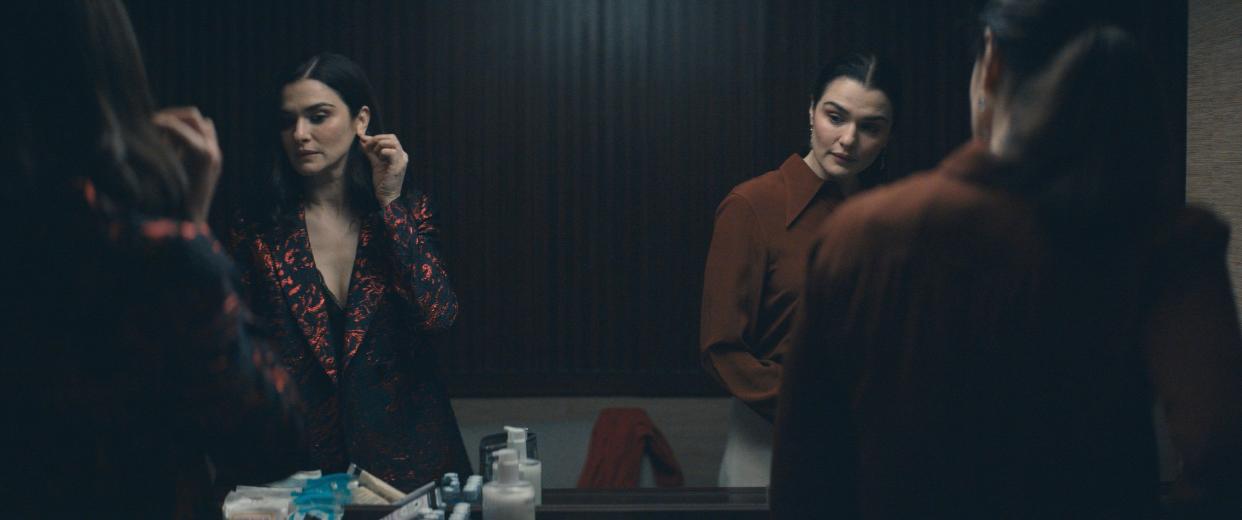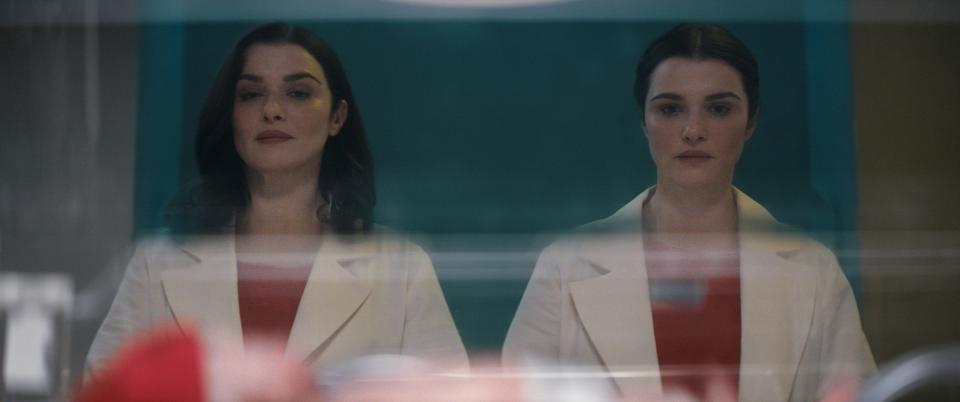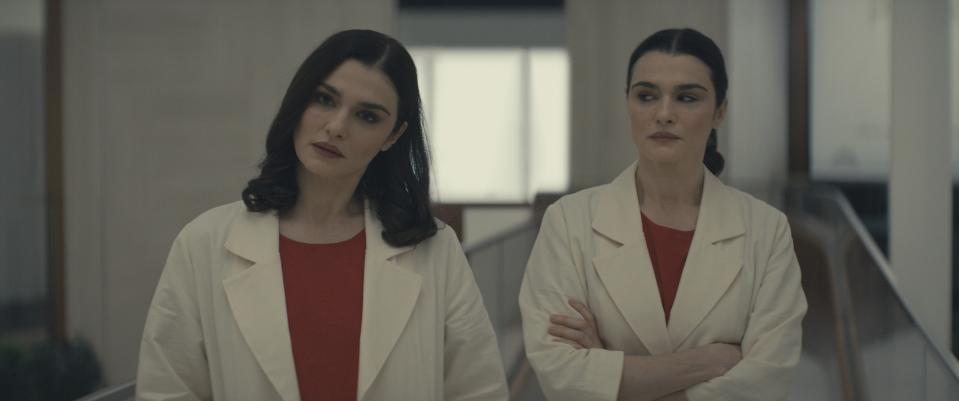‘Acting Itself Is a Visual Effect’: How Rachel Weisz Seamlessly Starred Opposite Herself on ‘Dead Ringers’

- Oops!Something went wrong.Please try again later.
On “Dead Ringers,” the Amazon Prime Video series based on David Cronenberg’s 1988 film, Rachel Weisz stars as twin OB-GYNs Elliot and Beverly Mantle, who share everything from drugs and lovers to ethically questionable methods for pushing women’s health forward. They also share the frame in an enormous number of scenes over the course of all six episodes of “Dead Ringers,” which created significant challenges for both Weisz and visual effects supervisor Eric Pascarelli.
Pascarelli, who was tasked with creating seamless images in which Weisz could act opposite herself as the twins, had previous experience from the 2020 HBO limited series “I Know This Much Is True,” starring Mark Ruffalo as twins that guided him on “Dead Ringers.” “The secret of the visual effects is a great actor,” Pascarelli told IndieWire. “Acting itself is a visual effect.”
More from IndieWire
How They Created That WTF Sandpit Sequence in 'Barry' Episode 4
'The Marvelous Mrs. Maisel' Flash Forwards Created a New Costume Challenge
Because Pascarelli knew “Dead Ringers” would live or die on the strength of Weisz’s performances, he and cinematographer Jody Lee Lipes (who also worked on “I Know This Much is True”) worked out a methodology that would give Weisz the most freedom and facilitate her best work — and allow the filmmakers to watch the scenes back on set and determine if they were working. “We wanted to make sure that everything was laid out in such a way that the acting could really shine,” Pascarelli said. “It was not necessarily the most efficient way, but the things we could have done to save time on set would have required cheats [in post] that would have kept us from knowing what we were getting on the day.”
For each scene in which Weisz acted opposite herself, the screen would essentially be divided into an “A” and a “B” side. The first takes would be Weisz on the “A” side of the frame — typically portraying Elliot, the larger personality —opposite her double, Kitty Hawthorne; once the filmmakers had a few takes that they liked, the best one would be selected and the production sound mixer quickly edited together a track of Weisz’s dialogue while she changed into costume for Beverly. Then, Weisz returned to shoot the “B” side of the frame with an earwig playing the dialogue in her ear while Hawthorne and the other actors pantomimed the scene. A motion control camera using SMPTE timecode and synchronized to the shutter of the camera ensured each side matched so that the second Weisz could be seamlessly composited into the shot in post.

©Amazon/Courtesy Everett Collection
“The video assist triggered everything,” Pascarelli said. “It was the timecode master of the whole process, and it synchronized audio and it synchronized the lighting board.” The latter was essential given the series’ stylized lighting and color shifts, as in a nightclub scene in the first episode. “There are a lot of dramatic lighting cues in the show. In the nightclub, the lights are all flashing, and those lights have to flash the same way on both twins or you’ll see that it doesn’t match. That was all synchronized using SMPTE timecode so that the motion control, lighting board, and audio would all speak a common language.” The filmmakers created what Pascarelli described as “a crude, hand-operated split screen” so that they could watch the interaction between the twin characters on the video assist system and make sure the eyelines matched and everyone was happy with the performances.
It was a painstaking process, but Pascarelli felt that the advantages were worth the effort. “We could have shot one side with a moving camera on a fluid head, and the second one locked off and then just tracked her in,” he said, “but then we wouldn’t have been able to visualize on set that everything was working properly. You have to get it right on both passes because if they’re looking at each other and the eyelines aren’t perfect, it’s amazing how sensitive you are to that.”
Amazingly given the technical precision of the final product, Pascarelli never planned anything before the day of the shoot. “I don’t like to do that if I don’t have to,” he said. “My philosophy as a visual effects supervisor is to let the filmmakers make the film. If there’s absolutely some way that I have to restrict it I will, but ideally, I don’t have to. We had all the necessary equipment there all the time, so I would come in for the actors’ rehearsal and figure out how to parse the frame based on the blocking and where the camera would be.”

©Amazon/Courtesy Everett Collection
The key was to get clean shots of Weisz as both Mantle twins, so occasionally Hawthorne would duck in the middle of a shot while Weisz crossed her; on a few rare occasions, the blocking required that Pascarelli use deep fake technology to map Weisz’s face onto Hawthorne’s. That was only done five or six times, however, and the filmmakers tried to avoid it. “The problem with that technology is that whatever Kitty’s acting becomes Rachel’s acting. Since this is a show about Rachel’s performance, we tried to limit those situations to situations where the second twin was basically standing there stone-faced,” Pascarelli said. One thing Pascarelli felt that the series had in common with Cronenberg’s original was a desire to keep things simple whenever possible. “We wanted to be as sparing as possible with the effects and keep the show-offy things to a minimum.”
As in Cronenberg’s film, “Dead Ringers” sustains the illusion by shooting the Mantle siblings as if two different actors portray them; there are no self-conscious visual effects that throw the audience out of the show. For Pascarelli, one of the most interesting things about the series is that the twinning effects are simultaneously obvious and unobtrusive. “You want to make the effects invisible, and your reward is if no one notices your work,” he said. “By the same token, it’s extremely visible because everyone knows there aren’t two Rachels. But the effect did ultimately become invisible thanks to Rachel — she just did a really amazing job, both technically and artistically.”
Best of IndieWire
Martin Scorsese's Favorite Movies: 60 Films the Director Wants You to See
Quentin Tarantino's Favorite Movies: 53 Films the Director Wants You to See
Sign up for Indiewire's Newsletter. For the latest news, follow us on Facebook, Twitter, and Instagram.
